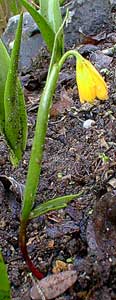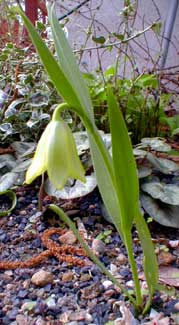
Yellow Bells; or,
Johnny-Jump-Up Fritillary
Little Johnny-Jump-Up said,
"It must be spring.
I saw a ladybug
And heard a robin sing."
-Edwina Fallis
(b.1876)
(b.1876)
 Fritillaria pudica is a dwarf fritillary that blooms by mid March & April, producing either a bright yellow or a yellow-green dangling bell-flower which ages to saffron red before it is finished, followed in due time by round seed pods. It is particularly fragrant, but the whole plant is so tiny it is difficult to get down close enough to smell it.
Fritillaria pudica is a dwarf fritillary that blooms by mid March & April, producing either a bright yellow or a yellow-green dangling bell-flower which ages to saffron red before it is finished, followed in due time by round seed pods. It is particularly fragrant, but the whole plant is so tiny it is difficult to get down close enough to smell it.The mid-March (2003) photo at the left & the April (2004) photo at the right are considerably bigger than life-size. The flower & its stem are only three inches tall, thus extremely easy to lose amidst even small groundcovers.
We initially planted the autumn bulbs near a concrete walkway in front of species tulips where we figured nothing could get in front of them, but even at that our imaginations had overestimated the size, & when they first appeared in late winter/early spring, we realized that for the future, these would have to be included in the miniature raised bed we'd created for a dwarf cyclamen ( Cyclamen intaminatum, visible in the background in the right-hand portrait).
They like a moist garden in spring but during summer dormancy they should be permitted nearly complete dryness, which makes them a very good mate for the similarly summer-dormant little Cyclamen.
F. pudica is a North American native wildflower & grows in Eastern Washington's sage country, grasslands & conifer forests. Its full range east of the Cascade Mountainss extends from British Columbia to Northern California, & through the center of the continent from Alberta to New Mexico.
Each tiny bulb produces one small yellow flower (occasionally two or rarely three), always closer to the ground than its few sword-shaped leaves. The flower is never higher than three inches, while the slender leaves can reach five inches though rarely even that tall.
The brightness of the yellow bells helps it overcome its diminuative size. It is capable of naturalizing, but is so small it is frequently kept from doing so by larger garden plants, for which reason some people prefer them for containers. Our miniature raised bed, though completely bottomless, almost qualifies as a container.
Eastern Washington native peoples used to gather the tiny bulbs to eat cooked. I couldn't bear to cook them! The bulbs range from being as tiny as a split pea, to the size of a wrinkled thumbnail, somewhat saucer-shaped with numerous pinhead-sized bulblets around the rim.